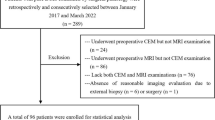Abstract
Breast cancer is one of the leading killers among women the world over. Widespread mammographic screening programs have led to almost 20% of breast cancers being detected when they are radiologically visible but clinically impalpable. For the localization of these cancers before surgical excision, the Kopan hook wire is the standard technique, but the extent of margins excised still needs to be determined. In this study, we have evaluated the accuracy of specimen mammogram (SM) with digital breast tomosynthesis (DBT) for margin assessment by comparing it to the excised margins as measured in final histopathology. This is a prospective observational study of patients with radiologically suspicious impalpable breast lesions. The patients underwent ultrasound-guided hook wire placement followed by excision of the lesion, subjected to digital tomosynthesis mammogram, and margins were revised on table when indicated. These findings were correlated with final histopathological margin. Our study included 30 patients and out of the 6 lesions, which showed positive margins on specimen mammography, 4 were histologically confirmed to have tumour at the surgical margin and 2 were confirmed to be tumour free. All DBT-positive margins were re-excised at the time of primary surgery. Individual comparison of the margins revealed a good agreement and high level of correlation between DBT and histopathology margins. None of the cases required a second surgery for margin revision. It can be concluded that specimen mammogram with DBT can be used as a reliable tool for intraoperative surgical margin assessment in non-palpable breast lesions to reduce rate of margin revision as well as reduce the volume of breast excised without compromising the oncological safety of the procedure.
Similar content being viewed by others
Data Availability
The data used to support the findings of this study are available from the corresponding author upon request.
References
Malvia S, Bagadi SA, Dubey US, Saxena S (2017) Epidemiology of breast cancer in Indian women: breast cancer epidemiology. Asia-Pac J Clin Oncol 13(4):289–295
Ferlay J, Soerjomataram I, Dikshit R, Eser S, Mathers C, Rebelo M, Parkin DM, Forman D, Bray F (2015) Cancer incidence and mortality worldwide: sources, methods and major patterns in GLOBOCAN 2012: Globocan 2012. Int J Cancer 136(5):E359–E386
Veronesi U, Luini A, Botteri E, Zurrida S, Monti S, Galimberti V, Cassano E, Latronico A, Pizzamiglio M, Viale G, Vezzoli D, Rotmensz N, Musmeci S, Bassi F, Burgoa L, Maisonneuve P, Paganelli G, Veronesi P (2010) Nonpalpable breast carcinomas: long-term evaluation of 1,258 cases. Oncologist 15(12):1248–1252
Das K, Sarkar DK, Karim R, Manna AK (2010) Preoperative ultrasound guided needle localisation for non-palpable breast lesions. Indian J Surg 72(2):117–123
Demiral G, Senol M, Bayraktar B, Ozturk H, Celik Y, Boluk S (2016) Diagnostic value of hook wire localization technique for non-palpable breast lesions. J Clin Med Res 8(5):389–395
Jakimovska Dimitrovska M, Mitreska N, Lazareska M, Stojovska Jovanovska E, Dodevski A, Stojkoski A (2015) Hook wire localization procedure and early detection of breast cancer - our experience. Open Access Maced J Med Sci 3(2):273
Ocal K, Dag A, Turkmenoglu O, Gunay EC, Yucel E, Duce MN (2011) Radioguided occult lesion localization versus wire-guided localization for non-palpable breast lesions: randomized controlled trial. Clin (Sao Paulo) 66(6):1003–1007
Goudreau SH, Joseph JP, Seiler SJ (2015) Preoperative radioactive seed localization for nonpalpable breast lesions: technique, pitfalls, and solutions. RadioGraphics 35(5):1319–1334
Tarkowski R, Rzaca M (2014) Cryosurgery in the treatment of women with breast cancer-a review. Gland Surg 3(2):88–93
Karanlik H, Ozgur I, Sahin D, Fayda M, Onder S, Yavuz E (2015) Intraoperative ultrasound reduces the need for re-excision in breast-conserving surgery. World J Surg Oncol 13:321
Chan BKY, Wiseberg-Firtell JA, Jois RHS, Jensen K, Audisio RA (2015) Localization techniques for guided surgical excision of non-palpable breast lesions. Cochrane Database Syst Rev (12):CD009206
Kim MJ, Kim CS, Park YS, Choi EH, Han KD (2016) The efficacy of intraoperative frozen section analysis during breast-conserving surgery for patients with ductal carcinoma in situ. Breast Cancer 10:BCBCR.S40868
Jorns JM, Visscher D, Sabel M, Breslin T, Healy P, Daignaut S, Myers JL, Wu AJ (2012) Intraoperative frozen section analysis of margins in breast conserving surgery significantly decreases reoperative rates: one-year experience at an ambulatory surgical center. Am J Clin Pathol 138(5):657–669
Amer HA, Schmitzberger F, Ingold-Heppner B, Kussmaul J, El Tohamy MF, Tantawy HI et al (2017) Digital breast tomosynthesis versus full-field digital mammography—which modality provides more accurate prediction of margin status in specimen radiography? Eur J Radiol 93:258–264
Graham RA, Homer MJ, Sigler CJ, Safaii H, Schmid CH, Marchant DJ, Smith TJ (1994) The efficacy of specimen radiography in evaluating the surgical margins of impalpable breast carcinoma. AJR Am J Roentgenol 162(1):33–36
Bimston D, Bebb G, Wagman L (2000) Is specimen mammography beneficial? Arch Surg 135:1083–1088
McCormick JT, Keleher AJ, Tikhomirov VB, Budway RJ, Caushaj PF (2004) Analysis of the use of specimen mammography in breast conservation therapy. Am J Surg 188(4):433–436
Author information
Authors and Affiliations
Corresponding author
Ethics declarations
The study was approved by the institutional review board and the institute’s Ethics Committee. The procedure was explained to them and an informed consent was taken.
Conflict of Interest
The authors declare that they have no conflicts of interest.
Additional information
Publisher’s Note
Springer Nature remains neutral with regard to jurisdictional claims in published maps and institutional affiliations.
Rights and permissions
About this article
Cite this article
Chand, J.T., Sharma, M.M., Dharmarajan, J.P. et al. Digital Breast Tomosynthesis as a Tool in Confirming Negative Surgical Margins in Non-palpable Breast Lesions. Indian J Surg Oncol 10, 624–628 (2019). https://doi.org/10.1007/s13193-019-00956-z
Received:
Accepted:
Published:
Issue Date:
DOI: https://doi.org/10.1007/s13193-019-00956-z




